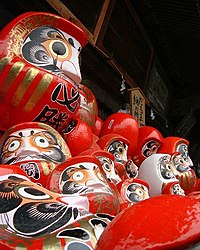Since Buddhism came to the West, first with Asian immigrants in the late 19th and early 20th century,1 and later among non-Asian converts, Buddhism has become a part of pop-culture. From personal experience, I’ve seen Zen cereal, Zen yogurt, Zen drinks, Zen clothing, and other meditation aids. An image search on “Zen pop culture” in Google revealed even weirder stuff, including romantic, um, furniture. The Worst Horse has no trouble finding other mis-uses of Buddhism in Pop-culture either.
But interesting, Japan also has interesting mis-uses of Buddhist terms that have since become part of the language. According to my handy cultural guide-book, a couple mis-used terms are dōraku (道楽) and zammai (三昧).
The word dōraku is a Japanese term for the joys of following the Buddhist path, with a kind of emphasis on the anticipation of Enlightenment. However, in day to day use, this can mean when someone takes something too far. If someone likes girls too much, they are onna dōraku (女道楽), or if a son wastes away his parents’ inheritance, he is dōraku musuko (道楽息子).
The word zanmai actually comes from the Sanskrit word samādhi which is a Buddhist term for attaining a great mental state through Buddhist long-term practice like meditation, tantra, visualization or even recitation (like the nembutsu).2 However, zammai, like dōraku, can mean someone whose taken something too far. For example, if someone is really living it up recklessly, you can say zeitaku zanmai (贅沢三昧).
Neither of these terms is that commonly used, but it’s fun to see how Buddhism becomes a part of pop-culture in sometimes unexpected ways. ![]()
Another fun example, though not linguistic, are the famous daruma dolls:

These of course are modeled after the famous Indian Buddhist monk Bodhidharma. More on these little guys another time. ![]()
1 People often assume it started with the Beat Generation and such, but Buddhism has been practiced in America generations earlier. In my temple, which is over 100 years old, someone once told me that before WWII, there were a considerable number of non-Japanese American practitioners, but Internment sort of killed the openness of the Buddhist community later, and set the movement back decades. Only now are things recovering again. More on that in a later post. :-/
2 There are way too many samadhis to list here, as different Buddhist sects emphasize different ones, and different texts, but they are kind of like milestones signifying some great attainment through dedication and practice. Then again, they are not required to attain awakening either, so Buddhists should know better than to compare how many samadhis they’ve attained compared to the other guy. People are hard-headed nevertheless. :-p

Language has a way of taking its own course with words changing meaning seemingly in spite of our best efforts. “Buddhist” words are even more woven into Southeast Asian languages in ways we might characterize as “mis-use”. For example, Burmese kan “luck” comes from kamma, or Cambodian sot “recite” comes from sutra. English-speaking Buddhists also “mis-use” Pali/Sanskrit words by making them even more “Buddhist”. A word like sangha had a more generic meaning in Pali, but brought into English, it has an elevated meaning referring specifically to a Buddhist community or even more restrictively to monks and nuns.
How about the missused Buddhist term 有難う arigatou?
I nearly bought a book on everyday words that have their roots in Buddhism like 不思議 fushigi. This is from 不可思議 fukashigi which anyone who recites the Amida Sutra in Japanese should recognize.
不可思議 is also a number (1 with 64 zeros). Also in the Amida Sutra is 恒河沙 gougaja which means the number of grains in the Ganges river, which is also a number (1 with 52 zeros)
http://atasinti.chu.jp/kazu/
I am still wondering about the term ぶつぶつ, I wonder if this term came from Pureland Buddhism in Japan…
Arun, Stephen, excellent, excellent comments. Thanks so much for the input!